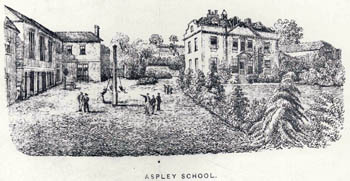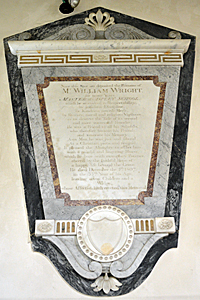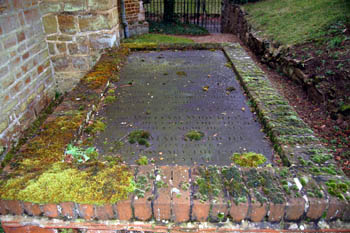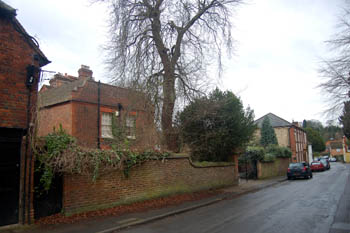Aspley Guise Classical Academy

Aspley Guise Classical Academy [Fac56] - the rear of Guise House (right) and Powage Press
Aspley Guise was famous in the eighteenth century for its Classical Academy. Not much in the way of records has survived but in the late 1970s A.E.Ashfield Wright pieced its history together (as a descendent of its most famous Headmaster William Wright). The school prepared the sons of gentlemen for careers in the services, church and commerce. The school was founded around 1715 by local yeoman Thomas Gressam with the support of the How family, the Quaker gentry family who lived at the Old House in the village. The school occupied Guise House and the neighbouring premises, now the Powage Press.

Powage House January 2008
Robert Sawell, another local man, took the school over in 1733 or 1734 and died, still as the master in 1770; he was succeeded by James Vaughan from Surrey, who himself died in 1778 and was succeeded by William Wright from Kempston, his mother was a niece of Robert Sawell.

The memorial to William Wright in the north aisle May 2017
Under him the school reached its highest watermark. The boys sent to the Classical Academy came from all over the country and from a high level in society, one boy was the son of Major General George Bowness of the East India Company another became the London architect Sir Robert Smirke who began the redesign of Milton Bryan church for Sir Robert Harry Inglis in the 1820s and also designed the British Museum and the General Post Office in London. Another boy, John Joseph Stockdale became a publisher in London, publishing the memoirs of the Duke of Wellington's Mistress Harriette Wilson, about which the Duke uttered the memorable line "publish and be damned".

The tomb of William Wright and his wife set against the north wall of Saint Botolph's church - January 2008
Wright died in 1807 and was buried in Aspley churchyard; Rev.Henry Nicholson succeeded him as headmaster. By 1818 the head seems to have been a Rev.Richard Pain and he ran it until a few years before his death in 1855, he too, was buried in the churchyard, not far from Wright. Pain's son seems to have continued the school for a few years and an attempt was made to revive it in 1864 by Dr.Henry Lovell of Winslow [Buckinghamshire] as a crammer for Public Schools. All the school buildings were sold in 1874 for £22,000.

The site of the Classical Academy (Guise House and Powage Press) in January 2008
Bedfordshire and Luton Archives and Records Service has the sale particulars of 1874 [GA2150]. The property was described as Aspley Schools and was sold by Edwin Fox and Bousfield of London at Tokenhouse Yard near the Bank of England. The description is as follows: "...Aspley Schools...have been established for over a century and a half, and with the Residence have from time to time been enlarged, improved, and fitted up with every modern appliance by each successive master. They are arranged to accommodate 50 pupils, and the necessary staff for masters and servants. The Private Residence, which is screened from the public road by shrubberies &c. contains on the Ground Floor - Hall, Drawing, Dining and Breakfast Rooms, with Six Bedrooms and W.C. In the Basement - Kitchen, Scullery, Larder, Housekeeper's Room, Cellars, and other requisite conveniences for a large establishment. At the rear is a private lawn and pleasure grounds laid out with taste, and in connection therewith is a Small Conservatory. There is extensive Stabling, Coach-house, Laundries, Brew-house, Sculleries &c., and above are roomy lofts for hay and straw, warehouse room, and other storage. A portion of the upper story [sic] has been reserved, and fitted up as a Range of Dormitories, to be used in illness or other pressing circumstances or emergencies. To the west of the private residence, divided therefrom by the playground (which is fitted with leaping bar and other conveniences to form a gymnasium) are the Sitting Rooms and Bedrooms for the Masters and Ushers, and Dormitories for the pupils, with an Extensive Dining Saloon accessible from the Kitchen of the Residence by a tunnel under the playground. There is also the library of the masters opening by French windows to playground well placed for the supervision of the scholars; adjacent are two other extensive school buildings. beneath the school rooms and opening into the playground is a large covered area for the use of the pupils in rough and rainy weather; there are also two private sitting rooms for junior masters. The lavatories, W.C.'s, urinals &c., are complete with every convenience. Opposite the Residence, and divided therefrom by the public road, is the terrace garden of over half an acre in extent, laid out in terrace beds, and planted with the most productive fruit and vegetables; bounded by and adjoining the public road, and above the terrace gardens is the far-famed "Powage". The pupils' cricketing and summer playground is eight acres in extent, and apart from the productive nature of its soil, commands some of the finest views in the county. The soil is sand, the water plentiful and pure, and the air considered the most healthy in the kingdom. A portion of the land from its position and the lovely views it commands might be used for the erection on one or more residences, while the remainder would be sufficient for the wants of the establishment, thus without detriment to the estate securing a reduction in the price".